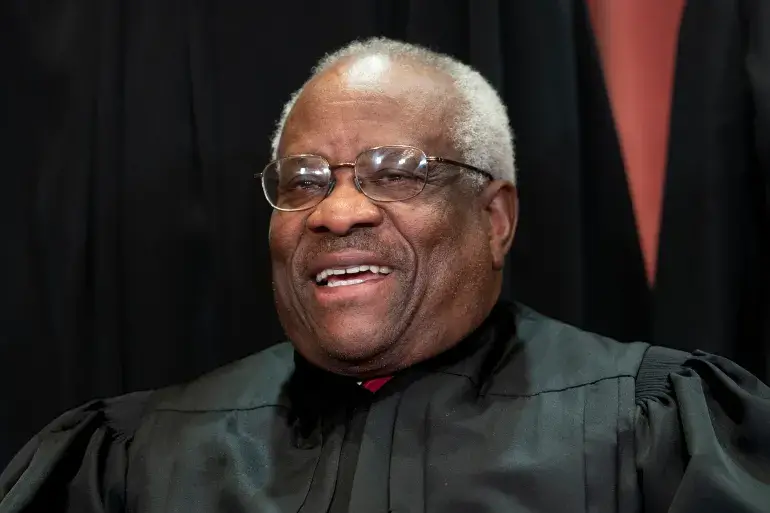A Masterclass from the Bench
For more than three decades, Justice Clarence Thomas has stood as the intellectual backbone of the U.S. Supreme Court’s conservative majority — often saying what others on the bench only think.
And this week, as the Court heard arguments on whether the Voting Rights Act (VRA) allows states to draw congressional maps based explicitly on race, Thomas once again demonstrated why he remains the most formidable legal mind of his generation.
His sharp, skeptical questioning cut through the rhetorical fog surrounding race-based redistricting — exposing the contradiction at the heart of the Democrats’ argument: that “equality” somehow requires treating Americans differently based on skin color.
“Would the maps that Louisiana have currently be used if they were not forced to consider race?” Thomas asked pointedly during oral arguments.
Louisiana Solicitor General Benjamin Aguinaga didn’t dodge the question.
“We drew it because the courts told us to,” Aguinaga replied. “They said a majority-Black district was required. And our legislature saw the marching order.”
That exchange — calm, factual, devastating — summed up the issue better than a thousand activist speeches. Thomas was reminding everyone in the courtroom that when government forces race into every political decision, it stops being about democracy and starts being about social engineering.
The Larger Battle: Race vs. Equality
The case before the Court centers on whether Louisiana must create an additional majority-Black district under the Voting Rights Act. Civil rights groups, heavily backed by Democratic political organizations, argue that the VRA compels states to prioritize race when drawing maps.
Conservatives counter that such an approach violates the Equal Protection Clause of the Fourteenth Amendment, which guarantees that all citizens — regardless of race — are treated equally under the law.
Thomas’s line of questioning made it clear which side of that argument he’s on.
For decades, he has warned that the modern interpretation of the VRA has drifted far from its original intent. What was once designed to ensure fair access to the ballot box has, in many cases, become a tool for permanent racial sorting — one that entrenches Democratic power while dividing Americans by color.
“Our Constitution is colorblind,” Thomas wrote in a prior opinion. “The law must treat each citizen as an individual, not as a member of a racial caste.”
That philosophy — simple, principled, and unyielding — has guided Thomas’s entire career.
A Legacy of Clarity and Courage
This week’s session came as Justice Thomas quietly marked 34 years on the Supreme Court — a career that began in controversy but has since become a pillar of constitutional originalism.
He was confirmed by a razor-thin 52–48 vote in 1991 after Democrats launched one of the most vicious character assaults in modern political history — an attempt not only to block his nomination, but to destroy his life and reputation.
They failed.
Today, even his critics acknowledge that Thomas’s influence has reshaped American law for a generation. His majority opinions — and even more, his concurrences and dissents — have laid the foundation for some of the Court’s most transformative decisions:
-
Dobbs v. Jackson Women’s Health (2022) — overturning Roe v. Wade and returning abortion policy to the states.
-
Bruen v. New York (2022) — restoring the Second Amendment’s original meaning.
-
Students for Fair Admissions v. Harvard (2023) — ending race-based college admissions.
-
Loper Bright v. Raimondo (2024) — curbing bureaucratic overreach by dismantling Chevron deference.
Each of these rulings carries Thomas’s unmistakable fingerprints: a deep commitment to textual fidelity, constitutional structure, and equal justice under the law.
Mark Paoletta on Thomas’s Enduring Impact
Former Trump administration official Mark Paoletta, one of Thomas’s closest allies, captured the magnitude of his influence in a post commemorating the anniversary of his confirmation:
“It’s impossible to overstate how important Justice Thomas’ confirmation has been to the saving of our constitutional Republic,” Paoletta wrote.
“The beginning of today’s Court started when Justice Thomas was confirmed 34 years ago, after Democrats launched an all-out war — complete with lies and smears — to not only defeat him but destroy him. But they failed spectacularly.”
Paoletta credited Thomas’s courage for blazing “the trail back to the Constitution’s original meaning,” noting that most of the Court’s landmark conservative decisions — from Harvard to Dobbs — can trace their intellectual roots back to Thomas’s early writings.
“Justice Thomas has lived the most inspiring American life,” he added. “He is an American hero and our nation’s greatest justice.”
Why Thomas Still Matters
What makes Clarence Thomas so effective — and so infuriating to his opponents — is that he’s immune to political intimidation.
Progressives have spent years trying to delegitimize him, painting him as out of touch or beholden to conservative donors. But their attacks always fall flat because Thomas’s jurisprudence is grounded not in ideology, but in timeless principle.
He doesn’t bend to elite opinion. He doesn’t care about media approval. And he doesn’t flinch when race is used as a political cudgel.
His skepticism toward race-based policymaking isn’t born of hostility — it’s born of faith in human equality.
Thomas grew up under segregation in Georgia. He has lived through the injustices that come from dividing society by race. And he’s spent his entire career fighting to ensure America doesn’t repeat those mistakes under a different name.
A Philosophical Divide That Defines Our Era
This latest Voting Rights Act case encapsulates the philosophical chasm between the Court’s two factions.
On one side, the left argues that “equity” requires different standards for different groups — that racial outcomes, not individual rights, are the measure of justice.
On the other, Thomas and his conservative colleagues insist that true equality means judging every person as an individual, not as a representative of a group.
It’s a question that cuts to the core of the American experiment. And Thomas, as always, is willing to ask what others won’t.
“If the government must sort citizens by race to ensure fairness,” he once asked in another case, “how will it ever stop?”
That question remains as urgent now as it was when he posed it twenty years ago.
The Man Who Outlasted His Critics
At 76, Justice Thomas shows no sign of slowing down. His opinions remain sharp, his influence unmatched. And the respect he commands from fellow justices — even those who disagree with him — speaks volumes.
Justice Amy Coney Barrett once remarked that Thomas “has the rare gift of making everyone in the room think harder.”
Even the late Justice Ruth Bader Ginsburg, no ideological ally, called him “a man of deep intellect and integrity.”
That respect isn’t just earned by his legal mind — it’s earned by the quiet dignity with which he has endured decades of attacks, smears, and distortions.
While many in Washington measure success by headlines or fame, Thomas measures it by one standard: fidelity to the Constitution.
Conclusion: The Smackdown That Echoed Beyond the Courtroom
When Clarence Thomas asked a simple, piercing question this week — “Would the maps that Louisiana have currently be used if they were not forced to consider race?” — it wasn’t just a comment on redistricting.
It was a reminder of the principle that has guided him for 34 years: that America’s promise of equality cannot coexist with government-mandated racial division.
His critics will call him outdated. His admirers will call him prophetic. But no one — not even his fiercest opponents — can deny his impact.
As the Supreme Court weighs yet another case that could reshape the nation’s legal landscape, one thing remains certain: Clarence Thomas is still leading the charge to restore the Constitution’s original promise — one argument, one question, one landmark decision at a time.

Adrian Hawthorne is a celebrated author and dedicated archivist who finds inspiration in the hidden stories of the past. Educated at Oxford, he now works at the National Archives, where preserving history fuels his evocative writing. Balancing archival precision with creative storytelling, Adrian founded the Hawthorne Institute of Literary Arts to mentor emerging writers and honor the timeless art of narrative.
